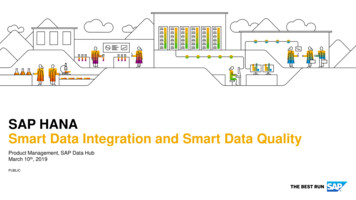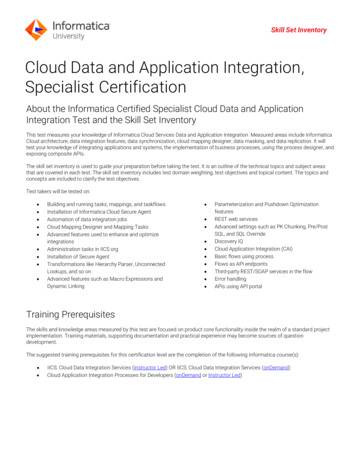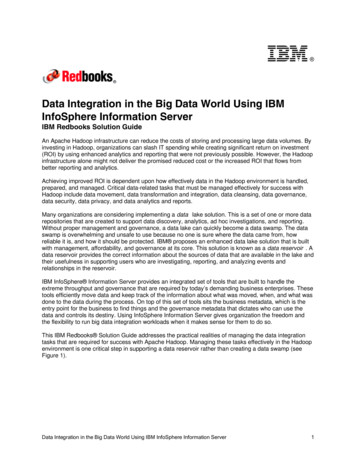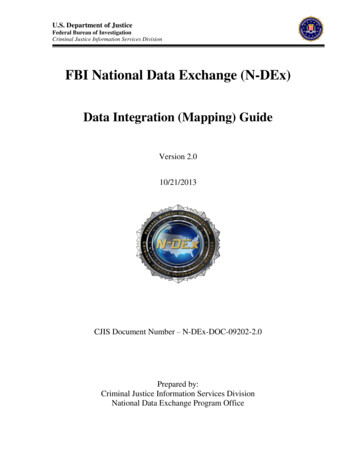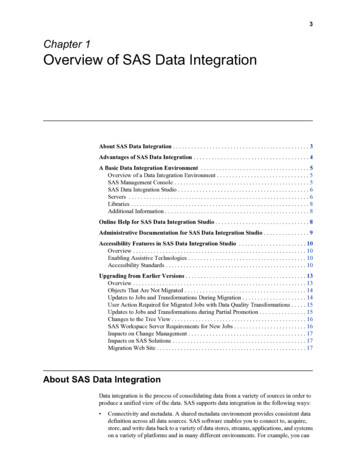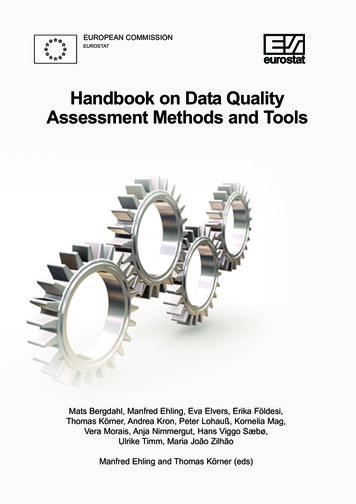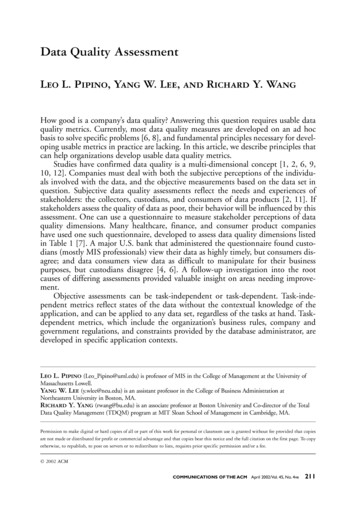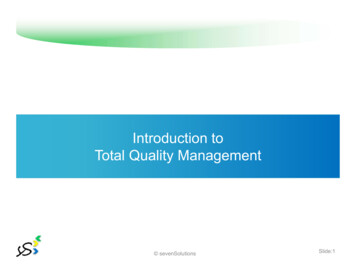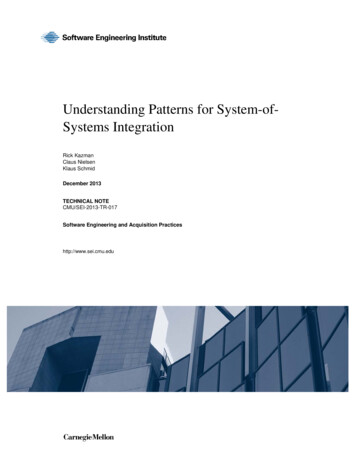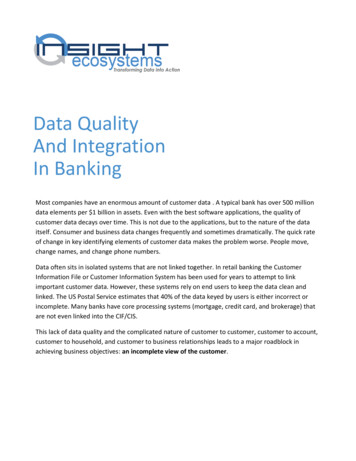
Transcription
Data QualityAnd IntegrationIn BankingMost companies have an enormous amount of customer data . A typical bank has over 500 milliondata elements per 1 billion in assets. Even with the best software applications, the quality ofcustomer data decays over time. This is not due to the applications, but to the nature of the dataitself. Consumer and business data changes frequently and sometimes dramatically. The quick rateof change in key identifying elements of customer data makes the problem worse. People move,change names, and change phone numbers.Data often sits in isolated systems that are not linked together. In retail banking the CustomerInformation File or Customer Information System has been used for years to attempt to linkimportant customer data. However, these systems rely on end users to keep the data clean andlinked. The US Postal Service estimates that 40% of the data keyed by users is either incorrect orincomplete. Many banks have core processing systems (mortgage, credit card, and brokerage) thatare not even linked into the CIF/CIS.This lack of data quality and the complicated nature of customer to customer, customer to account,customer to household, and customer to business relationships leads to a major roadblock inachieving business objectives: an incomplete view of the customer.
DATA QUALITY AND INTEGRATION IN BANKINGDATA QUALITY – A BUSINESS P ROBLEMMost IT and business people understand that poor data quality is a business problem. Studies showthat up to 25% of data in an average bank’s CIF/CIS is incorrect. Errors in customer data lead tonumerous issues that impact a bank’s bottom line. Some of these problems are easy to understandand measure. For example, incorrect addresses increase mail costs for a bank. Even for a smaller bankthat sends out 200,000 promotional mail pieces a year, a 25% error rate would account for 50,000 inmail costs.The expense and lost revenue resulting from poor data quality is often more subtle. Data qualityproblems start a chain reaction in a bank’s business processes. For example, bad data makes privacyviolations much more likely. Contacting the wrong person the wrong way can cost the bank up to 10,000 per incident. On a larger scale, data quality problems lead bankers to make the wrongdecisions both tactically and strategically, resulting in lost customers and decreased profitability.WHAT’S DRIVING DATA QUALITY?In many ways the high profile of the data quality issue is due to the banking industry’s need toprovide differentiating customer service, better marketing practices, and better customer value. Thelarge number of failures of CRM projects has pointed out the obvious need to fix data qualityproblems. Banks of all sizes have struggled with the implementation of front-office CRM tools,marketing CIFs, business intelligence tools, and analytical systems all because of data quality issues.Data provides the cornerstone to build these capabilities and achieve business goals; therefore, thehighest quality of data possible is required. Part of this cornerstone is the ability to see a completeview of the customer. To understand the full value of a relationship with a customer, you must beable to link all accounts that belong to an individual as well as identify other relationships that mightexist in the household or across business accounts. Additionally, you must know who within thebusiness structure owns the customer, where that customer does most of his or her business, andwhat products that customer has. Unfortunately, name and address information, which provides thekey to linking across accounts, is often entered inconsistently during account set up, and detailedinformation about who owns the account or what products the account contains gets buried inmultiple, unstructured fields along with other critical pieces of information.2Insight Ecosystems
DATA QUALITY AND INTEGRATION IN BANKINGMOVING TARGETSo, if data quality is so important, why haven’t banks fixed the problem? While it may seem like asimple problem on the surface, data quality has been more of an art than a science. The nature of theprimary problem, names and addresses, makes fixing the problem much more complex than itappears. Name and address data is quite unstructured in most systems. The address lines alone cancontain a huge variety of information about a customer. This data is almost always manually keyedinto bank systems leaving plenty of room for typos, transposed characters, and entry of data into thewrong fields.Over 4 millionpeople will turn 18 in20067.5% of thepopulation getsmarried every yearpopulation getsdivorced every yearNCHSNCHSNCHS1 in 6or 43 million peoplemove every yearand 15% leaveno new address0.74% of the40%1.5 millionof keyed customerdata has errorsnew addresses areadded every yearUSPSUSPSUSPSIt’s also important to understand that the data is a moving target. Customers constantly change keyinformation when they move, marry or divorce, and change names, phone numbers, or emailaddresses. Complexities in address information like street aliases and changes in ZIP codes complicatethe problem even further.THE 3600 VIEWFor years people in the financial services industry have talked about the need for a “360 0 view” or“single view “ of the customer. Whatever it is called, the objective is to present a complete,consistent, and correct picture of customers and businesses to all areas of an enterprise.While this is a very simple concept, it is extremely difficult to implement due to data quality issuesand a lack of understanding of the requirements. A single view of the customer can only be achievedwith clean data and a mechanism to link different customers and businesses together.Bank Customer Information Files or Customer Information Systems represent the oldest strategy forachieving this linkage. This strategy largely depends on individual users making those links as they selland service accounts. Over time, it has become clear that this approach has resulted in error rates ofInsight Ecosystems3
DATA QUALITY AND INTEGRATION IN BANKINGmore than 25%. These customer systems rarely have all of a bank’s relationships represented. Whilethe customer system has core deposit and loan relationships defined, it rarely has data on mortgages,credit cards, trust accounts, investments, or insurance products.CompleteThe 3600 view of the customer must be complete. That is, it must have all relevant data about thecustomer. Many banks calculate the profitability and value of a customer relationship based only oncore products in the customer information system. But what if the customer has a trust or investmentrelationship with the bank? Shouldn’t all of the relationships be considered?ConsistentThe 3600 view must also be consistent. Everyone must be looking at the customer in the same way.From analytical processes to retail delivery channels, the same information about the customer mustbe used. What if all of the relationships were considered for profitability analysis, but the customerservice representative in the branch could only see a fraction of those relationships?CorrectFinally, the 3600 view of the customer must be correct for the specific business process or person.While we usually speak of a “customer view”, a particular business process may need to look at awider perspective. For example, in marketing processes it may make more sense to use a 360 0 view ofa household. In fact, there may be requirements for several different views each of which must becomplete and consistent.Constructing the 3600 ViewThe key to constructing the 3600 view lies not in a particular application but in the data itself.Customer identity data is the lowest common denominator across all data sources. Name of theconsumer or business, physical address, telephone numbers, email addresses, SSN or Tax ID, birthdate, and driver’s license numbers can all be used to create the 360 0 view. This is far from a trivialprocess. Each of these data elements has its problems and they are all notorious for having dirty data.The most sophisticated and accurate techniques for using identity data involve using all of theelements in concert. The name and address fields from banking applications also contain importantdetails required to link individual customers and businesses. Locating and using relationship indicatorssuch as “and”, “or”, “doing business as”, or “custodial” are vital part of constructing the 360 0 view.4Insight Ecosystems
DATA QUALITY AND INTEGRATION IN BANKINGUsing the 3600 ViewIt is very important to realize that the 3600 view is only a means to an end. Achieving this view is avital step to using customer data wisely, but it is only one step. The 360 0 view must be used indownstream processes to truly affect business performance. Sales, customer service, profitabilityanalysis, relationship banking, fraud, and risk process can all be dramatically improved through thiscomplete, consistent, and correct picture of the customer.WHAT’S REQUIRED TO FIX THE PROBLEM?Fixing data quality and integration issues requires sophisticated software components, business rules,and serious expertise. The following description of the process details the requirements for achievingthe high data quality.ProfilingThe first step in addressing data quality problems is to understand the data content. The Profilingprocess looks at each data source and provides a profile of that data. The data profile shows howmany records and elements are in the data source and information about each field. This includes theunique values present in each field, maximum values, minimum values, and other attributes thatdescribe the data.ValidationValidation sets a baseline for standard information for each data element. It determines if a dataelement meets those standards and sets thresholds and rules for what to do if data does not meetthe expected standard. In some cases validation uses a list of acceptable values for each data elementto determine the validity of the incoming information. For other data elements, especially numericfields, ranges of acceptable values are used to check the data integrity.When data does not meet the validity standard, several different actions may be taken depending onthe applicable business rules. The data may be mapped to a default, grouped as an unknown value, oreven rejected if the discrepancy warrants it.ParsingParsing examines unstructured data and decomposes it into specific components. This is especiallyuseful for name and address data. Names must be parsed into prefix, first name, middle name, lastname, and suffix components. The different ethnicities of names make this particularly difficult. In asimilar fashion, address data must be broken into its components.Insight Ecosystems5
DATA QUALITY AND INTEGRATION IN BANKINGStandardizationStandardization looks at individual data elements and puts them into a standard representation. Forexample, the suffix “Jr” gets set as the accurate and standard abbreviation for “Junior.” Addresselements are standardized according to postal regulations. Another example includes simplifyingaddress information across core processing systems to standardize spelling and abbreviation forcities. For example, a single data source can have three variations of the same name entered by threedifferent users: “Saint Paul”, “St. Paul”, and “Sant Paul”.The same lack of consistency applies to other information in core systems such as dates, telephonenumbers, driver’s license number, SSN/TIN, and account numbers. To perform accurate dataintegration, all of this information must be represented consistently.TransformationData must be transformed at both the element and the structure level to be more suitable fordownstream processes. The transformation process can look across data elements to fix additionalerrors. For example, an intelligent comparison of SSN with date of birth and geographical data canspot consistency problems. The transformation function may also split or concatenate data.EnhancementIn many cases, the standardized and transformed data can be correct, but still missing keyinformation. Enhancement processes can add information that is missing from the original records.For example, salutation, gender, and other elements can be added based on name data. Addressescan also be enhanced by adding street direction and even apartment number.AuditCleansing processes are vital in meeting the overall business requirements and ensuring high qualitydata. To validate that the cleansing process is working correctly, all of its steps must be auditable.Auditing allows business users as well as processors to understand where the data comes from,where it goes, and how each function massages the data to make it higher quality. This is also knownas “data lineage.”IntegrationAfter the previous steps are complete, data must be constantly updated and integrated into the viewsnecessary to support other business processes. This ongoing integration requires an understanding ofrelationships often hidden in the data itself.Integration builds the foundation of the complete customer view by linking previously unconnectedinformation such as accounts held by the same individual or accounts held by different individuals6Insight Ecosystems
DATA QUALITY AND INTEGRATION IN BANKINGwithin the same household and tying this information to additional prospect, demographic, and leadinformation from external sources.Matching and GroupingTraditional data integration processes often bring all data together at a single point in time and thensort that data into groups of like records. These records are then merged together to form integratedrecords for specific purposes. When the integrated records must be updated, either with new data orupdates to existing identity data, all of the data must be brought together again in another massive,time consuming effort. This process often leads to data that is stale before it is used, almostimpossible to update in a timely fashion, and often difficult to use for other purposes. It also ignoresthe intelligence gained from integration in previous periods that can significantly enhance theaccuracy of integration.RecognitionTo solve the data quality problem and accomplish the bank’s larger business goals, the solution mustgo beyond matching and grouping to be much more flexible and dynamic when it comes tointegrating data. Because data will arrive at different intervals and in varying quantities—from singlerecords arriving continuously out of customer interactions in real time to larger batch files sent bycore processing systems—a different style of integration is required.Recognition works on a principal of learning about customer identities and relationships as data isprocessed. From the initial load to every additional transaction, the system learns and extractsmeaning from the customer elements in the data to constantly enhance integration capabilities. Thisdynamic, learning nature allows recognition functions to locate more complicated but often morevaluable relationships across multiple lines of business in an organization. Many integration systemsuse the primary information listed on accounts and do not look at secondary relationships to createlinks with other accounts across the business. A recognition component improves this model, forexample, by using a custodial relationship on a trust account and linking that to checking and savingsaccounts.The Recognize function takes identifying information from a record and uses that information todetermine if there is a matching individual or household already on a master index. Identifyinginformation includes elements such as name, address, phone number, account numbers, date ofbirth, driver’s license number, SSN/TIN, and external identifying data. This function must use “fuzzy”matching techniques to identify close matches in character data.Recognition also supports real-time access by channel applications to locate customer information if itis not found using traditional core system functions. The system supplies a persistent ID for eachindividual found; or, if the individual is new, adds that individual to the cross-reference and creates anew ID.Insight Ecosystems7
DATA QUALITY AND INTEGRATION IN BANKINGCore systems often use exact field matching to find individuals, which means that users in the frontoffice can often miss locating an individual’s information when only that individual information isavailable. The index that is created by recognition processes cross references individuals on a varietyof information such as name and address, account number, SSN, and phone number so that nomatter what information they enter, front office users will get back a complete view of the customer.Data StewardshipBanks must understand the various ways customer data is stored and create data standards driven bybusiness rules to catalogue and map information that spans multiple core systems, channelapplications, and external data sources. This process, known as “data stewardship”, treats data as abank asset to ensure that data is used consistently and accurately.THE VALUE OF QUALITY, INTEGRATED DATAThe process outlined above can improve the accuracy and value of data. While the process can beused to clean up a bank’s CIF/CIS, the value of clean, integrated data goes well beyond this. Forexample, clean data can be used to reduce expenses in the bank by reducing postage and the amountof returned mail and by increasing productivity of back-office staff. However, the value of quality dataextends far beyond these initial savings.Quality Data Lower mail costs Increased productivity3600 View OfThe Customer Improved customer satisfaction Deeper understanding of customer behavior Decreased attrition Increased customer and product profitability Improve acquisition efforts Improve business performanceBusinessInsightValueUsing quality data to produce a 3600 view of the customer in day-to-day interactions with customerscan lead to much higher customer satisfaction. Using that same integrated view, downstreambusiness processes that give insight into customer behavior can deliver value many times that of justsaving mail costs. For example, contacting a customer or prospect in the wrong way during marketingcampaigns could cost a bank 10,000 per incident. Using this insight to decrease attrition can savemillions of dollars in lost contribution.8Insight Ecosystems
DATA QUALITY AND INTEGRATION IN BANKINGWHAT ARE THE ALTERNATIVES ?The data quality problem for banks is not new. For years, banks have engaged third-parties to perform “scrubs” on their CIF/CIS data file. However, most experts agree that this approach to the problem only ensures name and address quality at a single point in time. More modern solutions focus onfrequent cleansing of not just name/address data, but of multiple data elements that can supportdownstream business processes. Top US banks are moving toward a continuous process that providesdaily and even real-time cleansing and integration. The following table summarizes some of the alternative available to banks today:AlternativesStrengthsWeaknessesService BureausExperience and history in cleansingname and address data for directmail.Offsite processing of data introduceslong wait times in what should be a continuous process. They only provide partof the solution.Data IntegrationToolsSophisticated software tools fordata quality.The implementation and integration ofthe tool can be very expensive. Onsitedata integration experts are needed torun the system on an ongoing basis.Customer HubsThese tools provide a modern CIF/CIS approach to house one “gold”copy of customer data.The root data quality issue remains.Modification of existing systems mustbe made to retrieve customer data fromthe hub.Professional ServicesHighly customized approach forlarge banks.These solutions can be extremely expensive with a minimum cost of 5 millionper year.Insight Ecosystems9
DATA QUALITY AND INTEGRATION IN BANKINGCONCLUSIONData quality and data integration are two important topics for today’s financial services companies.The lack of quality, integrated data is a serious business problem that can have a substantial impacton a bank’s financial performance. That is why large banks have spent millions of dollars on dataquality and integration efforts. These projects are supported by bank executives because theyunderstand the effect that good data has on key business processes. Smaller banks should partnerwith seasoned specialists who understand the problem to see similar benefits.A BOUT INSIGHT E COSYSTEMSInsight Ecosystems is an independently-owned, Arkansas-based customer relationship managementand business intelligence company. The company was founded and is staffed by industry innovatorswho served as senior executives at Fidelity Information Services and at Acxiom Corporation. From ourcollective experiences and extensive knowledge of banking information technology, we have createda unique system that solves business challenges that bankers have faced for decades.Insight Ecosystems provides clients with a business intelligence ecosystem that learns, grows, andchanges to meet their ever-expanding needs. Insight Ecosystems’ services and solutions empowercompanies to gain tangible insight into their customers, products, and financials, turning data intoinsight and insight into action.Insight Ecosystems16101 LaGrande Dr.Suite 100Little Rock, AR 72223501-448-0240501-448-0166 cosystems.comin-sight e-co-sys-temn. An environment of complex data processed within an analytical system that derivesunderlying, interdependent relationships and clearly communicates business knowledgethat is immediately useful and extremely valuable.Copyright 2007-2009 Insight Ecosystems LLC. All rights reserved.10Insight Ecosystems
To perform accurate data integration, all of this information must be represented consistently. Transformation Data must be transformed at both the element and the structure level to be more suitable for downstream processes. The transformation process can look across
